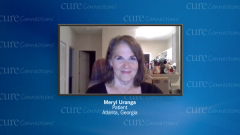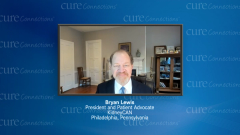
A Patient’s Perspective on Choosing Systemic Therapy for Metastatic RCC
Patients with clear cell renal cell carcinoma speak to their experiences with systemic treatments.
Episodes in this series

Chung-Han Lee, MD: Mr Lewis and Ms Uranga, tell me a little about the systemic treatments that you’ve had for your disease. What are the options that physicians have discussed with you?
Meryl Uranga: I’ll start. I was fortunate enough that once I had the local treatments, I didn’t have any progression or need for systemic treatment for about 18 months. Once there was an indication of that, I very seriously considered what my first move should be. As I mentioned earlier, I got a second opinion from a specialist in Texas, Dr Hans Hammers [UT Southwestern Medical Center]. We worked together with my oncologist locally. Because of my performance index — like you said about looking at the patient — we agreed on choosing to do the double immunotherapy. There was enough of a chance of a complete response, or at least a strong stable response, that I went that route.
I decided to do the ipilimumab [Yervoy]/nivolumab [Opdivo] treatment. The brand names are Yervoy and Opdivo, but we call it ipilimumab/nivolumab in our little world here. I undertook that. That’s the double immunotherapy. I had a good response to it. I also had a very serious side effect from it. It was both worlds. I went into it knowing the risks, and they were pretty high. But I felt like the risk/reward situation was worth it. I still feel very strongly that I made the right choice. That isn’t where I’m at right now. I’m now on the combination treatment, but I don’t know how much detail you want me to go into on that yet. That was where the first treatment went. I made it through 3 doses of ipilimumab before that had to be stopped for the side effect.
Chung-Han Lee, MD: I see. I’m sorry that you had the side effect. When we use combination immunotherapies, it’s not uncommon that the immune system gets a little too revved up and it can start to affect the body in ways that we prefer it not to. Do you want to speak about the second-line drug that you’re on right now?
Meryl Uranga: Yes. After the side effect, I was treated with a high-dose steroid. Once I was weaned down to a certain level, I went back to a mono-immunotherapy, which was the nivolumab. I stayed on that for a while, probably about a year. Then there was a little progression again. In July of 2019, I was switched over to the combination therapy that had just been FDA [Food and Drug Administration] approved, axitinib [Inlyta] and pembrolizumab [Keytruda]. I had a very good response to that initially, right off the bat. I had a heart rate issue. As soon as I started on the axitinib, I had a bradycardia [slow heart rate] issue, so I had to stop it and have a cardio workup. But once I got stable, everything was fine, and I continued on it. I’m still on that treatment, and it’s effective for me. I had 1 dose adjustment this past year from 5 mg to 7 mg twice a day for the axitinib. It was a proactive move, but it’s been fine. I’m still on the treatment.
Chung-Han Lee, MD: Great. Mr Lewis, you’ve been very fortunate in terms of not needing systemic therapy. Do you want to speak a little about what your experience has been?
Bryan Lewis: Sure. I’ll reflect for a moment on what you said, Dr Lee. It’s critical that your point is made to everybody that it’s crucial to take the patients’ situation into account right up front in a shared decision environment where there’s whatever support group or family or friends available to be a part of this. It’s also crucial to take into account social conditions, comorbidities, and other medical conditions. With all those things, it’s paramount that the patient community hear that and understand that’s a core principle.
I’m speaking on behalf of some other advocates out there. I take some offense with the stratification that uses some terminology that I don’t think is very nice to the patient community. When you hear you have poor prognosis, that’s not reassuring. I can’t change all the medical textbooks out there, but I’ll put a word in for some other advocates who have been saying that over the years.
But you hit on a big point, which is that in 2007, when I was diagnosed and thankfully through surgery was able to get through that, sunitinib was pretty much the only thing available other than IL [interleukin]-2. After that, other therapies started coming along very rapidly. You can correct me, but as of 2022, there are something like 12 or 14 different choices. With the combinations, you can multiply that. We’re not at a point where physicians are 100% confident with whichever selection is made. That’s tough for everybody. That’s why it’s one of the things KidneyCAN is involved with. We have to change that so that we know those answers. That’s where research comes in. That’s my little soapbox on that. Thank you for that opportunity.
Chung-Han Lee, MD: I certainly echo the naming of the groups, which certainly weren’t by my design. It makes for an awkward conversation with the patients when you’re talking with them about whether they have poor risk or a poor prognosis. That isn’t something that they like to hear in that initial patient encounter. But we have seen a lot of advancement in the field in a very short and rapid period of time.
Transcript edited for clarity.







